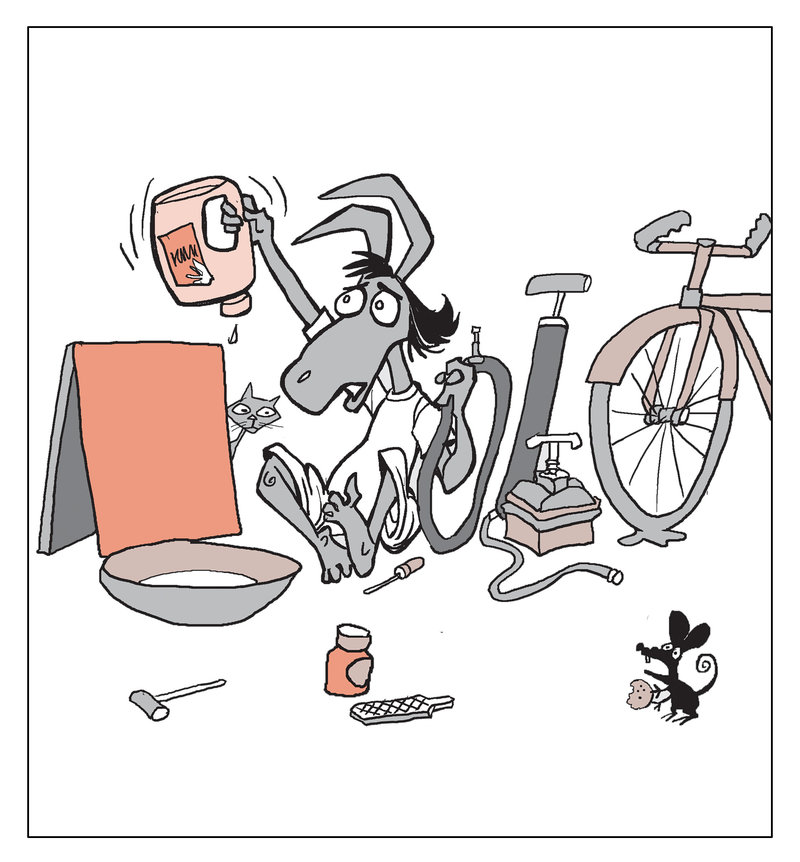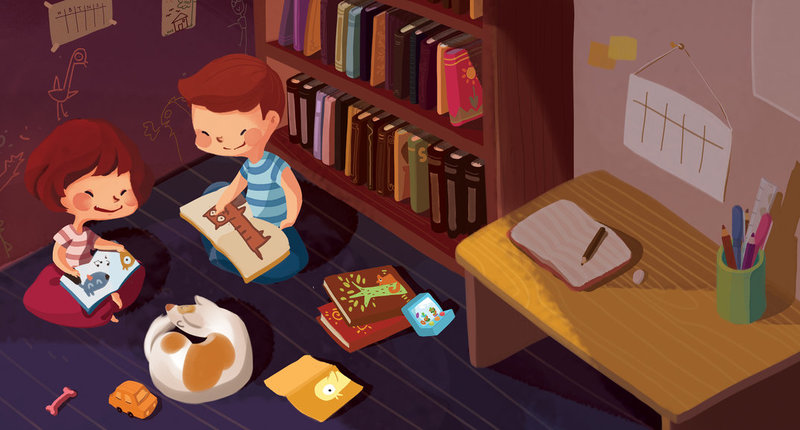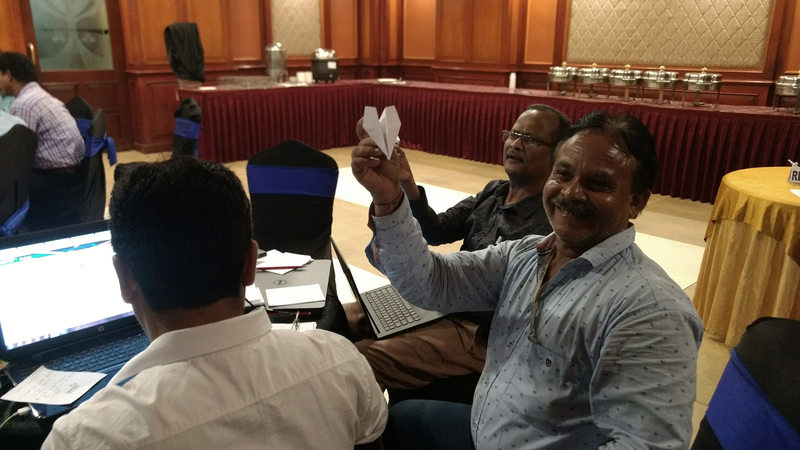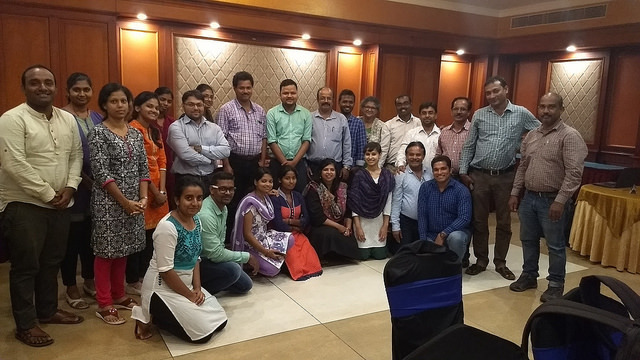The creator of Gardhab Das, Target Magazine's iconic cartoon character, on creating Gadbad Das for Pratham Books!
Posted by Amrita Bose on April 09, 2019If you grew up during the 80s and the 90s, you could not not have pored over copies of popular children’s (in today’s time it would have targeted the Young Adult category) magazine Target, published by the India Today group. A constant companion during long train journeys, sultry afternoons during summer vacations, copies of Target magazine were zealously guarded from annoying friends with borrowing-but-not-returning habits. Along with a slew of reader contributions, in-house features (anybody remembers that fantastic page dedicated to pen friends?) Target ran a bunch of popular comic strips including Detective Moochhwala by Ajit Ninan, Granny’s Gupshup by Praloy Chakravorty, It Happened in History by Renuka Narayanan. But perhaps the most memorable character remains Gardhab Das, a kurta-pajama wearing, harmonium wielding donkey, who was also an unemployed music teacher.

Co-created by cartoonist brothers Neelab and Jayanto Banerjee, Gardhab's favourite weapon for “mass destruction" was his singing talent or the lack of it. His singing mostly landed him in trouble, but sometimes it also got him out of sticky situations.
And bringing back the charm of Gardhab Das and the nostalgia associated with him is Jayanto with his newest creation for Pratham Books: Gadbad Das, son of Gardhabh, a millennial of sorts, but unfortunately for him, musical talent is still not in his genes. Gadbad lives in small town India. Like his pa, Gadbad is a terrible singer too. Everybody knows this, except him! Gadbad does various odd jobs to survive and solves his problems musically mostly. Like in his debut book — No Water for you, where Gadbad has to fix a puncture in his cycle shop, but he has run out of water. Off goes Gadbad to find some water, but it’s not as easy as you’d think.
Gadbad’s creator Jayanto, who has, post Target, done stints at India Today, Times of India, and Hindustan Times as a cartoonist, tells us why he decided to resurrect Gardhab Das into our lives again with his mini-me: Gadbad, reminisces about Target days and creating an iconic cartoon character.
What was the original inspiration for the Gardabh Das comic strip that ran in Target from 1980s to early 90s?
To do that I will have to go back to that era. This was the late 1980s and the editor of Target was Rosalind Wilson, a British lady. She wanted an Indian cartoon strip to be created as a double spread in the magazine and Neelabh and I met with her to discuss the possibility of creating a comic strip once in three months. Her brief to us was very clear, “It should be about your life [ we were from Lucknow], the comic strip needs to have a small town feel to it. We thought about it and decided that unlike every other comic strip that had superheroes, our hero basically would be a loser. He would be terrible at singing and unemployed and that kind of gave us that a fertile space to create really funny situations that protagonist Gardhab Das keeps getting into.
What was the appeal of Gardhab Das during his time?
Gardhab had to be an everyday character, and relatable to kids, their parents and grown ups as well. What was to be a three-monthly comic strip (featured as a double spread) soon became a monthly affair thanks to its immense popularity. In fact Gardhab became so popular that the comic strip became part of Target’s popular yearly diary, made it to annual issues and even got its own digest. There was a point in time when Gardhab was going to be killed off because its illustrator Neelab (Jayanto claims his brother was much better at creating Gardhab than him) had decided to move on, but the then editor Vijaya Ghosh insisted that Jayanto continue with the comic strip and it had another successful run for the next few years until the magazine shuttered.
What inspired you to create Garbad Das for Pratham Books? How is Gadbad similar or different from the legendary Gardabh Das?
Initially while discussing with the Pratham Books editorial team we wondered whether we should bring back the original Gardabh Das for the book. But we realised that Gardabh belonged to another era and we wanted to contemporise the character even though father and son have the same talents. Hence we decided to introduce Gadbad Das, son of Gardabh Das, a character who was born after the year 2000. Even though Gadbad might be contemporary, the look and feel of the character and the setting are more small town than metros. A hand pump, a very rare site in big cities is still prevalent in small town India. But water and water shortage is a common problem that plagues the entire country.
Jayanto hopes that Gadbad Das can become a series and become as popular as his illustrious father. Characters such as RK Laxman’s Common Man and the Amul Girl have grown on us, and are still going strong, so why not Gadbad Das, says Jayanto.
comments (7)
The Power of Open Licensing!
Posted by Remya Padmadas on August 09, 2019“Open source is a philosophy and a movement, and what makes open source thrive is the community that grows up around it.” says Abby Kerns in The Newstack. Community has no physical or geographical definition but rather is defined by a shared attitude, interest and goal and spans geography, religion and political affiliations. Stories are the soul of open-source platforms, which prompt children to rapid fluency in their mother tongue, before they can read simple sentences in English.
 Illustration by Huynh Thi Kim Lien for 'Don't Wake the Baby!'
Illustration by Huynh Thi Kim Lien for 'Don't Wake the Baby!'
Pratham Books’ StoryWeaver and Room to Read are partnering to combine the power of open, community and stories so that children can read over 400 storybooks in English, Bengali, Chinyanja, Chitonga, Hindi, Khmer, Lao, Marathi, Nepali, Sepedi, Sinhala, SiSwati, Kiswahili, Tamil, and Vietnamese. “Room to Read and Pratham Books share a common commitment to providing underserved children with high quality storybooks. We are delighted to have Room to Read’s books on our digital platform, StoryWeaver, which are now available under open licences, so that children everywhere can discover the joy of reading”, says Suzanne Singh, Chairperson Pratham Books.
Room to Read is a non-profit organization that seeks to transform the lives of millions of children in low-income countries by focusing on literacy and gender equality in education. Founded on the belief that “world change starts with educated children," the organization focuses on working in collaboration with local communities, partner organizations and governments to develop literacy skills and a habit of reading among primary school children.
They have partnered with StoryWeaver to publish 200 of their original language titles and their English versions on the StoryWeaver platform under the Creative Commons CC BY 4.0 license. The StoryWeaver team has worked closely with Room to Read on editing these titles for publishing in Engalish, doing image enhancements and migrating the books to the platform. Alisha Berger, Global Publisher at Room to Read says “We are thrilled to partner with Pratham Books’ StoryWeaver to bring our books into the digital space for the first time. We hope these 400 openly-licensed books will inspire, motivate, and share the joy of reading with the wide and engaged audience on Storyweaver, as well as showcase Room to Read’s 20-year commitment to making exciting and fun books for children in their local languages.”
Having these storybooks under the CC BY license on StoryWeaver takes these Room to Read stories to a larger audience, worldwide. At the same time, it gives the StoryWeaver community new stories to read and translate, thereby giving children around the world access to more stories in their mother tongue. Many of these stories have already been versioned into other languages like Punjabi, Filipino, Malayalam, French, Italian and others. Here’s hoping the stories continue to grow so as to put a book in every child’s hand.
If you would like to partner with us please write to [email protected]
Be the first to comment.StoryWeaver’s exciting foray into the East.
Posted by Remya Padmadas on September 26, 2017The Outreach team recently made a big leap towards reaching children in West Bengal and Odisha through two workshops conducted in Kolkata and Bhubaneshwar.
First stop: Kolkata.
We prepped for the workshop, famous Kusum rolls in hand and Kolkata in turn rewarded us with a fantastic turnout. Around 60 participants joined us from 12+ organizations working with children across the education and social sector. People had traveled from Asansol, Purulia, Bardhaman,Chandipur and even Jamshedpur for the workshop! We were amazed by the level of engagement everyone brought to the table throughout the all-day session. One such organization which attended in large numbers was Vikramshila Education Resource Society which works on a range of projects from early childhood education to capacity building from Ladakh in the North to Andaman in the South. One of their team-members raised the point that in West Bengal, if you travel 20km in any direction, the dialect and vocabulary changes. This slipperiness of the language can make teaching and reading a real challenge.

“What happens when the vocabulary of the teacher is not understood by the students and vice versa though both are speaking slight variations of the same language? What happens when students don’t relate to the texts they are reading?”
These very pertinent questions were echoed by many of the organizations in attendance. Fortunately we also had with us an example of a possible solution in the form of two gentlemen from Suchana. Suchana is a 10 year old community group, which works in Birbhum district of West Bengal towards the education of pre-school to class 10 children from Santal and Kora adivasi communities. Their teacher-translators have used the ‘Translate’ functionality of StoryWeaver to great effect to develop supplementary reading materials in Kora and Santali. Currently, 27 Kora books and 19 Santali books, both in Bengali script are on StoryWeaver; all this made possible by the Creative Commons license we follow.
The ensuing discussion was another aspect of our workshops: to bring people doing such good work in different ways into the same space so that they can begin to talk to each other and find areas of synergy.
We jumped into speaking about how Pratham Books came into being and how StoryWeaver was designed to spread the power of stories to all children, particularly those with limited means to access quality books. We delved into our repository of free content from flashcards and spotting books for early readers to our STEM and Life-Skills based books. The books can be used in a variety of ways: getting children to relate things in their science class to real life, using illustrations as speaking or writing prompts, and so on.
We had with us storytellers, teachers, librarians, program managers and content heads. They all put their heads together to visualize how to adapt the LSRW (Listening - Speaking - Reading - Writing) framework and content on StoryWeaver to their programs. Kolkata being the city of adda, we got into a debate of course about what kind of content we can and cannot show our children.
After a demo of how to translate and create your own stories on the platform, the participants got to work. We ended with different groups showcasing stories they had created on the platform during their work-time and we bid adieu with a group picture.
On to Bhubaneshwar we went!
We were greeted by the green, clean city with wide roads and took advantage of the day to plan for the workshop and also to fill our stomachs with ‘dalma’! The next morning at the workshop people began pouring in from diverse organizations like Patang and Nilachal Seva Pratisthan who work in rural areas on programs including literacy for children and employable skill-development training for young adults. A number of organizations working with tribal children and reading and literacy programs were also in attendance such as SELCO, American India Foundation and Bakul Foundation. All of us were gathered in the room with one mission - how do we get children of Odisha access to more books to read in languages they love and understand.
The main challenge that came up during discussion was once again finding adequate content and stories that represented experiences children could actually relate to, in languages that they felt comfortable with. This was where we introduced the audience to our Adi Kahani series- a set of 10 books based on the culture of tribal communities in Odisha, with stories developed and illustrated by local writers and illustrators and published in local tribal languages.
Participants curated and presented lists of stories based on themes they wanted to teach like using ‘Cube Cat Cone Cat’ to teach shapes and dimensions in Math. Some interesting directions were explored during the course of the workshop: Gram Tarang which is involved in skill training and also runs Tarang Vaani, an IVR radio was interested in recording some of our stories and airing them on radio to reach a wider audience! A team member from Sikshasandhan immediately expressed interest in collaborating to make this happen.
The most lively time came during an ice breaker post lunch: we had to learn how to make paper planes out of the resource challenges we’d previously penned down, fly them across the room and pick up a different plane to see if there was any overlap in challenges faced. After all the plane throwing and giggling was over, we settled down into work-time where participants aired the sentiment of common resource challenge and shared the stories they’d translated into Odia and some new creations as well.

With a last hurrah and a group picture, we said goodbye to Bhubaneshwar. It had been a long, productive week and we were ready to go home and catch some well-deserved rest.
